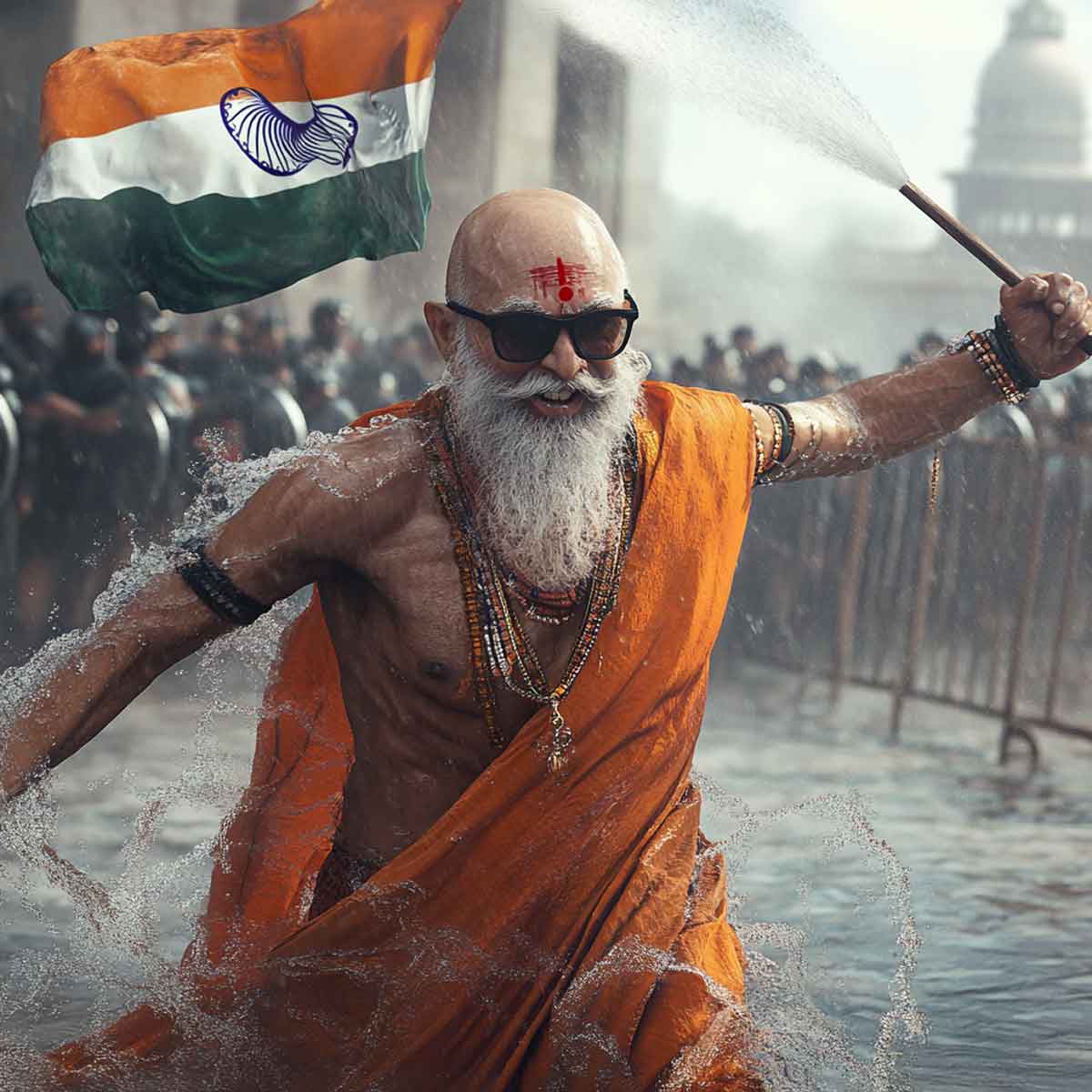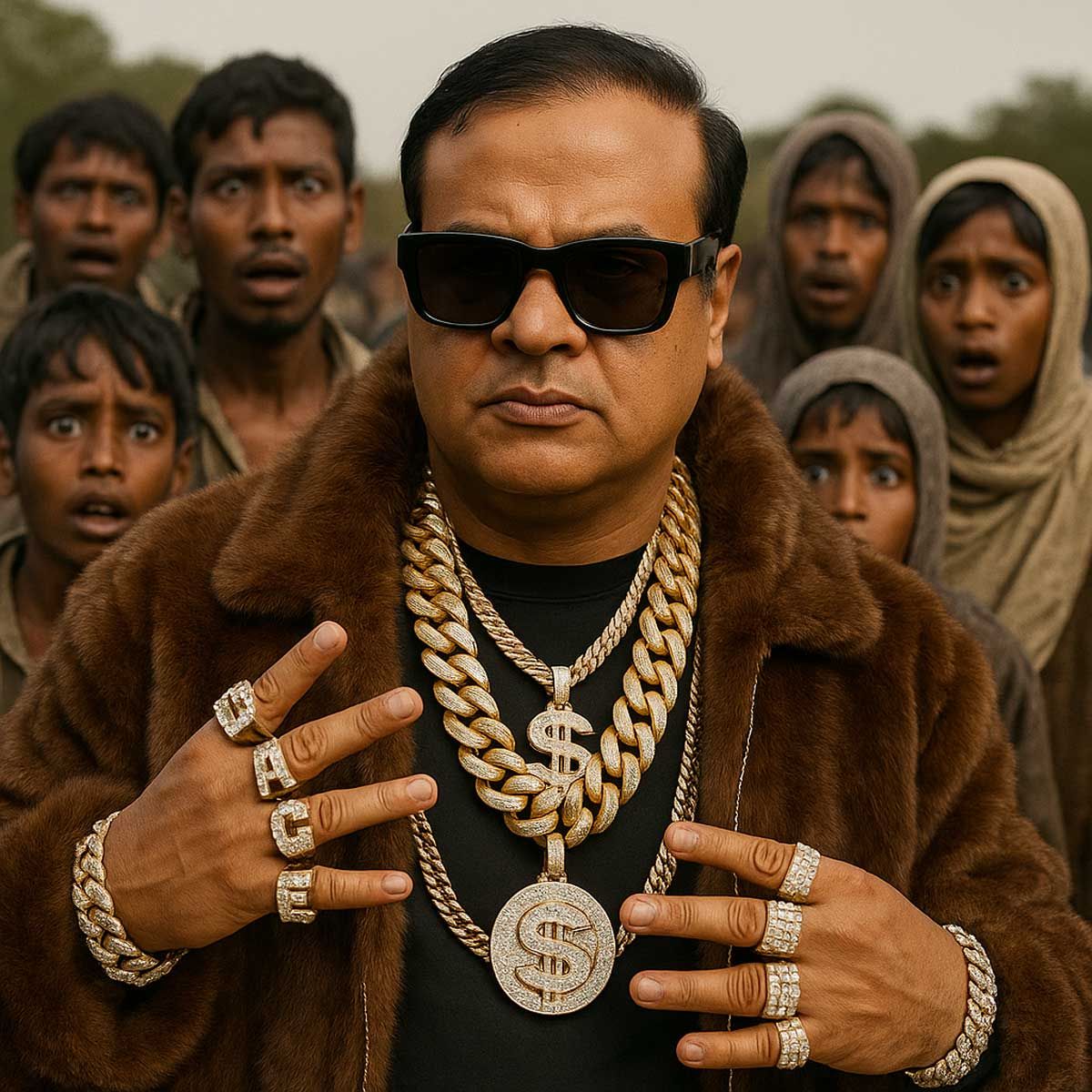More Coverage
Twitter Coverage
Satyaagrah
Written on
Satyaagrah
Written on
Satyaagrah
Written on
Satyaagrah
Written on
Satyaagrah
Written on
JOIN SATYAAGRAH SOCIAL MEDIA
"जब नाश मनुज पर छाता है": Kolkata erupts in chaos as police unleash tear gas, water cannons & lathi charge on peaceful 'Nabanna Abhijan' protestors demanding Chief Minister Mamata Banerjee's resignation over mishandling of the RG Kar Medical College case

In a display of force that has sparked widespread criticism, the Kolkata Police on Tuesday resorted to lathi charges, tear gas, and water cannons in a bid to disperse crowds of protestors at the Kolkata end of Howrah Bridge and near Santragachhi Railway Station on Kona Expressway. These actions were taken as demonstrators tried to bypass police barricades during their 'Nabanna Abhijan'—a march aimed at storming the state secretariat, Nabanna.
|
The confrontation reached a peak at Santragachhi, where agitators, fueled by their determination to be heard, threw bricks at police forces, resulting in injuries to several officers. In a distressing counterclaim, protestors also reported that the police's aggressive tactics led to injuries among several students, highlighting a troubling clash between law enforcement and civilians.
The 'Nabanna Abhijan' was not just a spontaneous outburst but a calculated protest with the express purpose of demanding the ouster of West Bengal Chief Minister Mamata Banerjee. This demand comes in the wake of the heinous rape-murder of a doctor at RG Kar Medical College, an incident that has sent shockwaves through the community and intensified public outcry against the state administration.
According to police reports, the escalation of force became necessary after protestors successfully breached several barricades and aggressively confronted security personnel. This serious breach of peace led the police to employ more drastic measures to control the situation.
The events took a more organized form with the involvement of the student organization 'Paschim Banga Chhatra Samaj' and a coalition of disgruntled state government employees under the banner 'Sangrami Joutha Mancha'. Their joint effort in the 'Nabanna Abhijan' saw hundreds of participants, predominantly youths, rallying from two different locations across the city, signaling a significant mobilization against perceived injustices by the state government.
|
The actions taken by the Kolkata Police and the ensuing violence at the protest have stirred a heated debate about the appropriateness of such forceful tactics and the broader implications for civil liberties under the West Bengal government.
The rally known as 'Nabanna Abhijan', spearheaded by the student collective 'Chhatrasamaj' and the state government employee group 'Sangrami Joutha Mancha', commenced from two strategic points—College Square in north Kolkata and Santragachi in Howrah. This mobilization marked a critical point in the local political landscape, as it was fueled by a deep-seated demand for accountability and justice.
One passionate participant at the rally expressed an unwavering determination, stating, "We will reach Nabanna no matter what. We must get to the state secretariat to demand the resignation of the Chief Minister, whose administration has been trying to shield the perpetrators of this heinous crime and suppress the incident. We want to hear from her." This sentiment underscored the protestors' resolve to not only confront but actively challenge the governmental structures they hold responsible for injustice.
In a statement that highlighted the nonpartisan nature of the protest, Chhatrasamaj spokesperson Sayan Lahiri clarified the group's intentions, saying, "Despite provocations, we intend to keep this a peaceful, democratic movement against the horrific crime committed against our sister at R G Kar hospital. We demand justice for her and her family. The call for justice by the people of Bengal and the country must be acknowledged by the Mamata Banerjee government." Lahiri’s words resonated with a plea for peace and justice, reflecting a deep commitment to democratic principles in the face of adversity.
The dual rallies, originating from College Square and Santragachi, were not just a protest but a significant outcry against what many see as a pattern of governmental neglect and mishandling. Participants rallied under the banner of justice, driven by a collective outcry over the rape and murder of a doctor—an incident that has become a focal point for broader grievances against the state leadership.
|
Police Use Water Cannons as 'Nabanna Abhijan' Rally Turns Violent
In anticipation of the 'Nabanna Abhijan' march, the Kolkata Police has issued a comprehensive traffic advisory to manage the expected disruptions. The advisory details specific routes for vehicles: those coming from the Kolaghat direction along NH 16 intending to use the 2nd Hooghly Bridge are advised to take Nibedita Setu from Nibra towards Kolkata. Similarly, vehicles arriving from the Dankuni side with the same destination in mind can also access Nibedita Setu to head towards Kolkata.
Further instructions were given for Howrah-bound vehicles originating from Kolkata, which intend to use either the 2nd Hooghly Bridge or Howrah Bridge; these vehicles should use Nibedita Setu. Meanwhile, Kolkata-bound traffic from Howrah Railway Station, looking to access Howrah Bridge or the 2nd Hooghly Bridge, is directed to proceed through GT Road and use Nibedita Setu.
Amidst these logistical adjustments, a significant political intervention has come from West Bengal's Governor CV Ananda Bose, who has taken a firm stance in support of the protestors. He invoked a recent Supreme Court ruling to emphasize the importance of peaceful protest within the democratic framework. Governor Bose passionately stated, "I would urge upon the government to remember the strong pronouncement of the Supreme Court of India. Let not the power of the state of West Bengal be unleashed on peaceful protesters. Democracy can have a silent majority, not a silenced majority. Remember that.”
|
BJP's Suvendu Adhikari Accuses Police of "Brutal Repression" Against Peaceful 'Nabanna Abhijan' Protesters in Kolkata and Howrah
In a significant escalation of tensions surrounding the 'Nabanna Abhijan' rally, BJP leader Suvendu Adhikari has openly criticized the Kolkata Police, accusing them of "brutal repression" against protesters who he claims were engaging in a peaceful demonstration. This rally, driven by students and various organizations, marches towards the West Bengal state secretariat today, with participants voicing their dissent against what they perceive as severe governmental failures.
Key points of contention around the 'Nabanna Abhijan' rally include accusations from the ruling Trinamool Congress that the protest could serve as a breeding ground for violence, prompting the Kolkata Police to declare the rally 'illegal'. Furthermore, the government has enforced prohibitory orders around the Nabanna area, attempting to curb the gathering amidst growing unrest.
The core of the protesters' grievances lies in their demand for Chief Minister Mamata Banerjee's resignation, sparked by the alleged mishandling of the RG Kar incident. This incident involved the brutal rape and murder of a trainee doctor while on duty, an event that has ignited widespread anger and calls for justice.
In an effort to demonstrate consideration for the public's routine, the student organizers of the rally have assured that their march will not disrupt the UGC-NET examinations, which are scheduled to occur in two shifts. Despite these assurances, the prevailing uncertainty has led several educational institutions to switch to online classes or declare a holiday on the day of the rally, reflecting a broader impact on the community.
Meanwhile, investigative actions continue to unfold in the background, with the Central Bureau of Investigation (CBI) conducting two rounds of polygraph tests on Sandip Ghosh, the former principal of RG Kar Medical College. Additional lie detection tests have been carried out on Sanjoy Roy, the prime suspect in the murder case.
The legal proceedings are also moving forward, as the Calcutta High Court has recently mandated the CBI to submit a progress report by September 17 on their ongoing investigation into the alleged financial irregularities at RG Kar hospital.
|
BJP Will Stall West Bengal Tomorrow, Warns LoP Suvendu Adhikari
In a sharp rebuke of law enforcement tactics, Suvendu Adhikari, the Leader of the Opposition in the West Bengal Assembly, has vehemently accused the police of "brutal repression" against the demonstrators of the 'Nabanna Abhijan' rally. The protests, which have taken place in both Kolkata and Howrah, are a direct response to the tragic rape-murder incident at RG Kar Medical College and Hospital. Adhikari has issued a stern warning, indicating that the BJP is prepared to bring the state to a halt if the "brutalities" by the state administration persist.
Detailing the actions taken by the police, Adhikari reported, "Police are using water cannons on peaceful protesters at Santragachi, firing tear gas shells at students on Howrah Bridge, and lathicharging them at College Street. These brutalities must stop immediately." His comments highlight the aggressive measures used by law enforcement against the protestors, sparking significant controversy and raising questions about the proportionality and necessity of such responses.
Adhikari further emphasized the potential for escalating political action, stating, "If the police repression doesn't stop, we (BJP) will stall West Bengal tomorrow." This declaration underscores the political tension that is intensifying in the state, signaling a possible major disruption in response to the ongoing crisis.
On Tuesday, a particularly tumultuous scene unfolded on Howrah Bridge and other strategic locations. Security personnel deployed tear gas, water cannons, and lathicharges in an attempt to disperse the crowds marching toward the West Bengal State Secretariat, Nabanna. The protest, fueled by outrage over the handling of the RG Kar case, saw protestors clashing with police, climbing atop barricades, and forcefully removing barriers set up in the Santragachi area, demonstrating their determination to be heard.
Amid these chaotic scenes, the Kolkata Police took action to detain several protestors from Howrah Bridge, all part of the 'Nabanna Abhiyan' march. These detentions have added another layer of controversy, with many viewing them as further evidence of the state's harsh stance against dissent and peaceful protest.
During the 'Nabanna Abhiyan' march, protestors were met with substantial police force as they attempted to break through the barricades outside the Bengal secretariat, expressing their demands for justice and accountability. The scene at the march was charged, with demonstrators facing tear gas and water cannons, signaling their strong resolve and deep frustration, especially over the handling of the rape-murder case at RG Kar Medical College and Hospital.
|
Protestors demonstrated their determination by climbing and dismantling barricades at Santragachi in Howrah, a significant point of contention between them and law enforcement. This moment highlighted their efforts to advance their cause forcefully.
In a strategic response to the protest, over 6000 police personnel were deployed outside Nabanna, setting up a three-layer security protocol to manage and potentially stifle the protest activities. These demonstrators, primarily students, called for the resignation of Chief Minister Mamata Banerjee, attributing to her administration a delay in justice for the RG Kar incident.
Amidst these events, the Central Bureau of Investigation (CBI) was active, examining the residence and documents of Saptarshi Chatterjee, medical superintendent and vice president at RG Kar hospital. Chatterjee stated, "The CBI team came to my office to see all the documents and computers, hard disk. They seized and took away all the items and gave us a seizure list... I went to the CGO complex yesterday to authenticate my signature which was already there on all the documents."
Additionally, controversial measures were noted ahead of the protest, with police allegedly instructing volunteers to oil the barricades to prevent protestors from gaining a grip, as captured in a video circulated among the public.
The Trinamool Congress condemned the rally as illegal and a potential cause for widespread unrest, a sentiment opposed by Chhatra Samaj spokesperson Sayan Lahiri who defended the protest's intentions, stating, “The claims made by the TMC and police are baseless. We aim to raise our demands peacefully.” This interaction highlights the contrasting views on the legality and nature of the protest, emphasizing the ongoing tension between the protestors and state authorities.
 |
 Support Us
Support Us
Satyagraha was born from the heart of our land, with an undying aim to unveil the true essence of Bharat. It seeks to illuminate the hidden tales of our valiant freedom fighters and the rich chronicles that haven't yet sung their complete melody in the mainstream.
While platforms like NDTV and 'The Wire' effortlessly garner funds under the banner of safeguarding democracy, we at Satyagraha walk a different path. Our strength and resonance come from you. In this journey to weave a stronger Bharat, every little contribution amplifies our voice. Let's come together, contribute as you can, and champion the true spirit of our nation.
 |  |  |
| ICICI Bank of Satyaagrah | Razorpay Bank of Satyaagrah | PayPal Bank of Satyaagrah - For International Payments |
If all above doesn't work, then try the LINK below:
Please share the article on other platforms
DISCLAIMER: The author is solely responsible for the views expressed in this article. The author carries the responsibility for citing and/or licensing of images utilized within the text. The website also frequently uses non-commercial images for representational purposes only in line with the article. We are not responsible for the authenticity of such images. If some images have a copyright issue, we request the person/entity to contact us at This email address is being protected from spambots. You need JavaScript enabled to view it. and we will take the necessary actions to resolve the issue.
Related Articles
- Kolkata erupts in outrage as residents turn off lights in solidarity, Swiggy and Zomato partners lead massive protest, uniting thousands to demand justice for the brutally murdered RG Kar doctor, accusing Mamata Banerjee’s govt of a failed investigation
- Junior doctors in Kolkata are on a fast-unto-death demanding justice for a murdered colleague and better healthcare conditions; Aniket Mahato, a key protestor, is critically ill in the ICU, IMA and private hospitals support the growing movement for change
- "Enough is enough:" President Murmu declares on the Kolkata doctor's rape-murder case, asking, "Where have we erred? And what can we do to remove the errors?" as she demands urgent reforms to protect women and end societal indifference
- "पर्दा है, पर्दा ": Outrage in Kolkata as 42 doctors transferred and a student is arrested for criticizing Mamata Banerjee, amid protests over the horrific rape-murder of a junior doctor at RG Kar Medical College; Nirbhaya's mother demands accountability
- "असीमित क्रूरता": Autopsy reveals Sanjoy Roy, a Kolkata police volunteer and trained boxer, slammed the doctor’s head against a wall, breaking her neck, while glass shards pierced her eyes as she fought to resist before being brutally raped and murdered
- "जाको राखे दीदी": CBI takes charge of the Kolkata rape case amid allegations of hospital evidence tampering, with BJP accusing officials of destroying the crime scene under the guise of renovation; the victim's family was misled about her tragic murder
- "मेरा मुल्क, मेरा देश, मेरा ये वतन": In response to the brutal murder at RG Kar College, Kolkata Police arrest student Kirti Sharma and others; TMC leaders threaten dissenters with violence, warning that those who criticize will have their fingers broken
- "Reclaim the Night": A seismic movement echoing across West Bengal under CM Mamata Banerjee, poised to profoundly shake the govt's roots in response to the brutal rape and murder of a doctor, left with a broken neck, damaged eyes & severe genital injuries
- "खेला होबे — Don’t expect anything from me”: New Principal Suhrita Pal loses her cool at RG Kar Hospital amidst escalating tensions over a trainee doctor’s murder and rape, with gym trainer involvement & Kolkata Police accused of bullying and suppression
- "किजिये मीटिंग मीटिंग": In response to the 'absolute failure of state machinery,' Calcutta High Court lambasts the West Bengal govt, threatening to close RG Kar Hospital & relocate patients, while ordering a CBI probe into the alarming vandalism incident
- "का का छी छी": Bikash Ranjan Bhattacharya accuses Mamata Banerjee of using a rate card for rape victims and buying witnesses; concerns deepen with reports of a hurried cremation in Kolkata, suggesting police involvement in covering up evidence
- “The government is hanging me”: Sanjay Roy, accused in the RG Kar Medical College rape-murder case, claims he is being framed by the govt as his daily trial starts November 11 with CBI presenting DNA evidence, CCTV footage, and mobile location records
- "विनाशकाले": After the Kolkata doctor rape and murder, now an IAS officer’s wife raped twice at gunpoint while her husband posted outside Bengal, with police purposely delaying the case, Calcutta High Court lambasted Mamata Banerjee's govt for its failure
- "जिंदगी के बाद भी": CBI reveals shocking illegal activities at Kolkata’s RG Kar Hospital, including videos of sex with dead bodies in the morgue, a thriving porn racket, missing bodies, deep corruption, and the unresolved murder of student Soumitra Biswas
- "जनता की याददाश्त": In a chilling recall of Kolkata's escalating violence, an unidentified woman’s brutally injured body found in Anandapur following the horrifying RG Kar Hospital rape & murder case, BJP slams Mamata Banerjee for failing to protect women




























